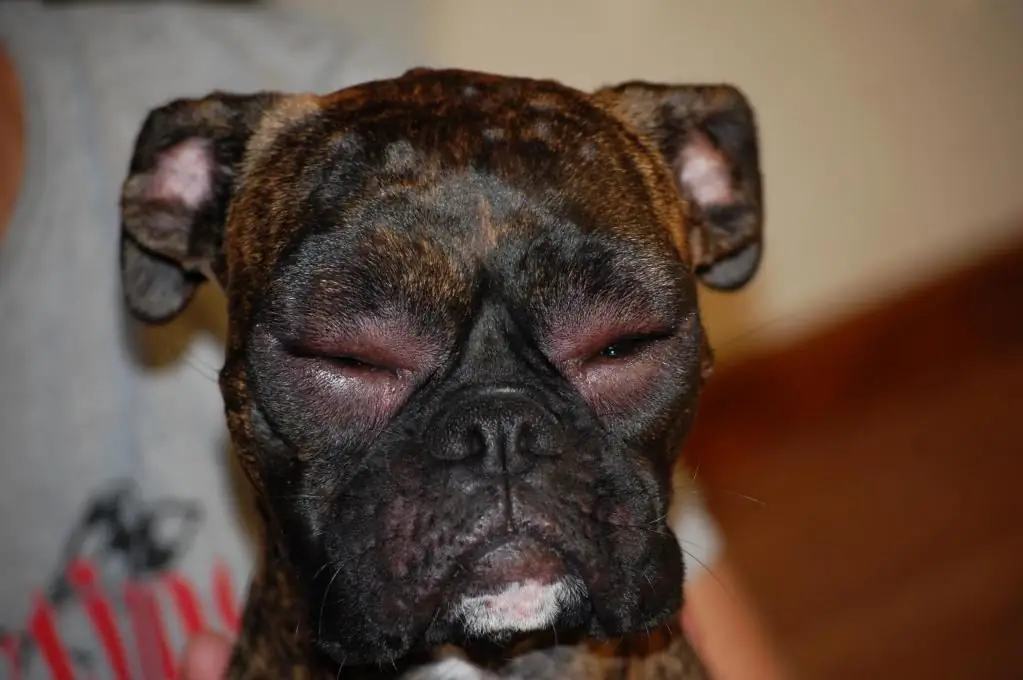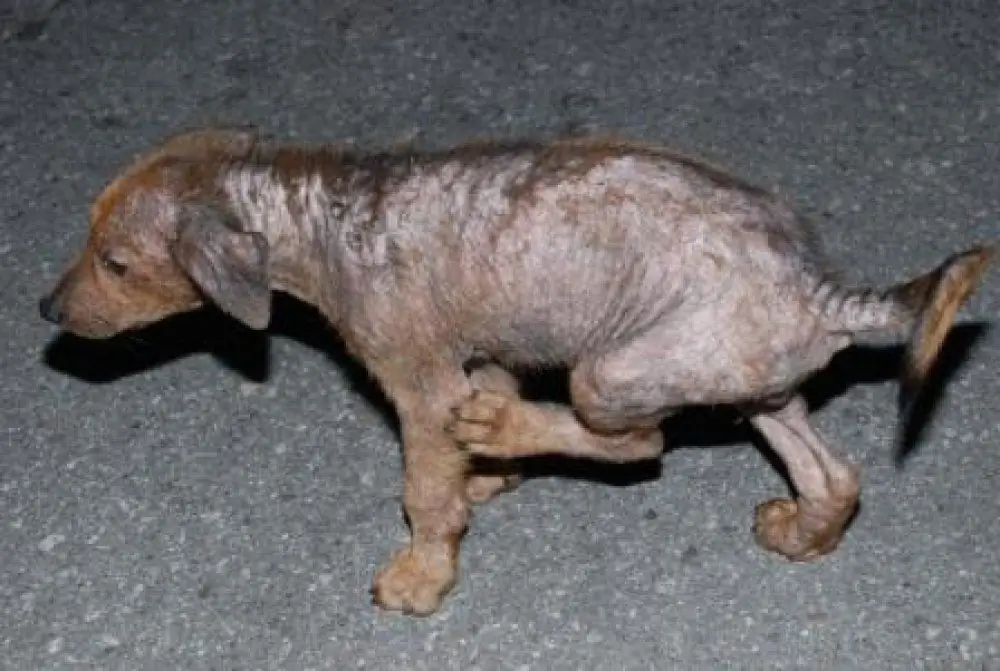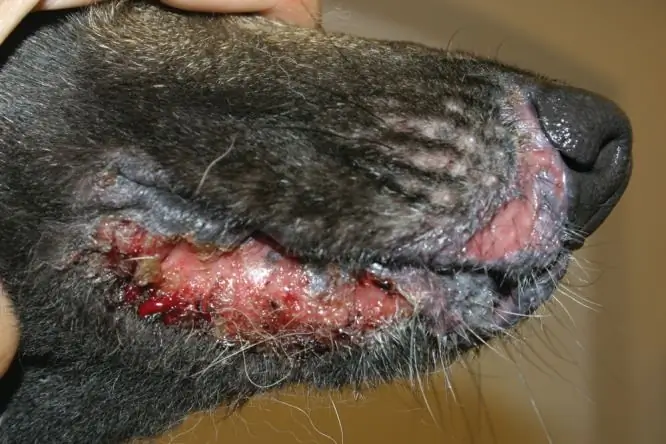2025 Author: Priscilla Miln | [email protected]. Last modified: 2025-01-22 17:55:19
All animals, unfortunately, get sick sooner or later. All pets are at risk of infection. There are skin diseases in dogs, in an aquarium in fish, cats, and so on. This is more common in dogs than in any other animal. The reason for this is that they spend most of their time outdoors. The reason that affects the occurrence of such diseases is the deterioration of the environment and ecology in general.
When skin diseases appear in cats and dogs, the owners first of all think that it is lichen. Such a disease can occur not only for this reason. There are several types of rashes on the skin of animals, the appearance and causes of which are fundamentally different.
If you find a similar ailment in your pet, you should definitely contact your veterinarian. Do not treat the dog at your own discretion, because it can harm the animal.
Types of diseases
There are four groups into which skin diseases in dogs are divided. Each type of rash has its own causes:
- Allergic.
- Fungal.
- Parasitic.
- Bacterial.
Primary actions
Once skin diseases have been found on a dog's body, there are a number of steps to be taken to protect yourself, as some types of skin diseases in dogs can be contagious to humans.
- Do not pet your pet.
- Not allowed to sleep in the master's bed.
- Exclude dog contact with children.
- Observe personal hygiene for all family members.
- Do not brush the dog to avoid spreading infection.
Allergic diseases
Such types of skin diseases in dogs are not uncommon. Especially often, small pedigree dogs and those that are genetically prone to such reactions suffer from allergies. Also, with a decrease in immunity, an allergy may begin to appear, even if it has never been.
Allergy is a reaction of antibodies in the body of an animal to certain irritants. An increase in the level of histamine in the blood causes an inflammatory process on the pet's body.
Allergic reaction most commonly caused by:
- food;
- chemicals present in household products, flea collars, etc.;
- drugs (drugs containing penicillin are the most dangerous);
- fleas.

Allergy symptoms
This disease affects all organs and systems of the animal:
- appearance of hemorrhages (in the mucous membranes and on the skin);
- vomiting and diarrhea when the digestive system is affected;
- convulsions if the nervous system is affected;
- rashes, redness and rashes on the skin, hair loss (with food allergies);
- point redness and itching, especially in the groin area (for flea allergies);
- redness and itching at the site of contact with the allergen (atopic dermatitis);
- allergic otitis media is manifested by increased temperature of the auricle, scratching, itching and redness.
Primary Allergy Treatment
When skin diseases are detected in dogs, symptoms and treatment should be determined immediately. A seemingly harmless allergy can cause angioedema and paralysis of the pharynx if delayed with treatment.
Before starting treatment, you need to identify the cause of the allergic reaction. Without eliminating it, it is impossible to cure the dog, as the allergy will return and the symptoms will intensify and worsen each time.

If the cause is a food allergy, remove the food from the dog's diet immediately. If this food has such an effect, then you need to immediately change it to another. If you are allergic to fleas and other bloodsuckers, take disinfecting measures. After that, regularly inspect the animal and, if parasites are detected, fight immediately.
In any case, the dog must be given an antihistamine. Allergy pills are sold in any pharmacy, it is not necessary to look for a remedy in a veterinary clinic.
Fungal diseases
Skin disease in dogs, the symptoms of which suggest that it iscaused by a fungus, are divided into different types, but they all have the same name - ringworm.
Trichophytosis is a disease caused by pathogenic fungi. Most often, this type of disease is given the simplified name "ringworm". The negative and most important feature of this skin disease in dogs, the photo of which is below, is that it is contagious and transmitted to humans. Carriers can be infected animals, people, and even blood-sucking insects. Regardless of the breed of dog and its size, any animal can become infected. However, those with short hair are more likely to be exposed to it.

Symptoms of a fungal disease
This skin disease in dogs, the symptoms and treatment of which are known to many dog owners, is distinguished by several main signs by which the diagnosis is made:
- asymmetrical round spots appearing on the animal's body;
- the surface of the spots peels off and a gray coating forms;
- in places of greater distribution on the skin, several round lesions are formed, interconnected;
- abundant hair loss at the sites of infection, the remaining hairs stick together;
- reddening of affected areas.
The main sites of ringworm infection are the base of the skull, the area between the ears, the base of the tail, and the creases of the elbows and knees.

Treatment
Treatment of skin diseases in dogs (photo of fungal infectionbelow) is prescribed only by a veterinarian. In no case should you resort to self-treatment of a dog, since there are toxic substances in the list of medicines, if the dosage is incorrect, a fatal outcome is possible.
In the treatment of ringworm, treatment is prescribed in several stages:
- External use of ointments.
- Vaccines given by injection.
- Administration of antifungals is done by a veterinarian as the drug is toxic and requires precise dosage.
Besides this, the treatment is combined with baths of medicinal preparations. The most important thing in the treatment of ringworm is the strict disinfection of the living quarters, clothing and bed linen. A fungus is a "cunning" disease that, even after a cure, can return again if timely disinfection is not done.
Parasitic diseases
The most common diseases caused by ticks and fleas are flea dermatitis, as there is not a single dog that has not brought home these parasites.
The second known skin disease in dogs is sarcoptic mange and otdecosis caused by parasitic mites.
Scabies symptoms
When sarcoptic mange the animal suffers from severe itching in the head, neck and paws. Moreover, the dog combs the wounds to blood, inflammation and pulls out hair.
During otdektosis, the auricles are combed and sulfur accumulates heavily.

In addition to these two diseases, parasitic species includescabies: glandular, ear and itchy scabies. These diseases are caused by small mites that live in the sebaceous glands and skin. Depending on the type of ticks, this skin disease in dogs is divided into the above types.
In scabies or aranchnosis of any kind, the symptoms are similar to each other. Itching is mainly observed in the auricles, knee and elbow joints. Over time, small parasites affect an increasing area on the body of the animal, and also affect the nervous system. It is then that the dog experiences incredible itching, wounds appear due to constant scratching. If scabies is not treated on time, then the dog's metabolism is disturbed and exhaustion begins. In addition, some types of this disease are contagious to humans. Therefore, as soon as signs of scabies appear, you should immediately contact your veterinarian.
Treatment of scabies
When diagnosing scabies of any kind, complex treatment is prescribed. First of all, it is necessary to soothe the itching and destroy the parasites. After the dog stops itching, it is necessary to accelerate the restoration of damaged skin with the help of external application of ointments. Medications to increase immunity are also prescribed in the first place. In an advanced case, antibiotics are prescribed for dogs with a skin disease. This speeds up the overall recovery process.
Scabies is a very dangerous disease, as not all animals can be fully cured. With further stress or reduced immunity, the disease may return.

Demodicosis
Another type of parasitic skin disease in dogs. It is caused by the spread of a subcutaneous tick through the lymphatic system, affecting the spleen. Often, a tick that has fallen under the skin of a dog becomes overgrown with a capsular membrane, which causes an inflammatory process and blood poisoning. This process is called encapsulation.

Symptoms
Not a single owner can fail to notice demodicosis, even one who knows nothing about dog diseases:
- First of all, the wool begins to fall out in whole bunches. Most often on the muzzle, back, paws and chest, but also occurs elsewhere.
- Acne appears on these areas, resembling black dots. It will not be possible to squeeze them out, only the skin of the animal will be damaged.
- Wool sticks together in breeds with long "hair".
- Fistulas and abscesses appear.
Treatment of demodicosis
This skin disease in dogs is extremely dangerous and severe. Therefore, in no case should you self-medicate an animal, but only contact a veterinarian. With a thorough examination and confirmation of the diagnosis, the animal is shaved baldly so that the medicines have access to get into all layers of the skin.
The first aspect in the treatment of demodicosis is careful hygiene of the animal with an antibacterial shampoo. The dog should be in a warm and dry place. In food, you need to add more vitamin A, which is found in carrots. Increased immunity with demodicosisvital, because if the dog feels unwell, it will not be possible to cure him.
Complex treatment works in different directions:
- destruction of parasites;
- skin wound healing;
- strengthening immunity;
- remove toxins from the body.
Antibiotics and all other medicines are prescribed only by a doctor after a complete diagnosis. Self-treatment of an animal at home can be fatal.
Bacterial diseases
Bacterial infection of the skin is an attack of a dog by microorganisms. The disease is provoked by streptococcus and staphylococcus aureus. Infection can occur even with a scratch or splinter. The infection enters the wound and the disease progresses. The most common bacterial skin disease in dogs is pyoderma.

Pyoderma symptoms
- Three to five days after the injury, itching and inflammation occur in certain areas of the body. In the process, the infection spreads to he althy areas of the skin.
- The appearance of a rash with pus inside in the abdomen, on the muzzle and genitals.
- The rashes burst, the leaked liquid infects neighboring skin areas. Severe itching occurs.
- Inflammation spreads throughout the body due to scratching, wounds form.
- If treatment is delayed, the disease becomes deeper and bleeding ulcers appear.
- Moist erosion forms in the folds of the skin, causingbad smell.
In some cases, immunomodulators are prescribed for skin diseases in dogs.
Treatment
Treatment is determined by the veterinarian based on the type of pyoderma, the area affected and the general he alth of the dog.
Treatment begins with the elimination of itching, treatment and disinfection of the skin. Hair is cut off, purulent rashes and formed crusts are removed. The affected areas are treated with wound healing agents. If necessary, a course of antibiotics is prescribed.
Pyoderma is contagious to humans, so you should not forget about your own disinfection and hygiene.

As soon as you notice a skin disease in a dog that fits any of the above, you should immediately contact your veterinarian. Any negative changes in the pet's he alth can be dangerous both for him and for humans. Do not self-medicate, so as not to aggravate the situation. How to treat skin diseases in dogs, the doctor will tell after a complete examination of the pet.
Recommended:
Dry skin in a child. Dry skin in a child - causes. Why does a child have dry skin?

The condition of a person's skin can tell a lot. Most of the diseases known to us have certain manifestations on the skin in the list of symptoms. Parents should pay attention to any changes, whether it is dry skin in a child, redness or peeling
Diseases in dogs: symptoms and treatment, photo

The dog quickly becomes a member of the family, and everyone perceives its illness very close to heart. To notice the approaching danger in time, you need to be able to distinguish between the most common diseases and know their symptoms
Otitis in dogs: treatment with antibiotics and folk remedies. Types and symptoms of otitis media in dogs

Otitis is an inflammation of the ear, which gives a lot of discomfort not only to people, but also to our smaller brothers. It is worth noting that animals are much more likely to suffer from such an ailment. If, after cleaning your pet's ears, you notice that the dog's ears are dirty again the next day, she constantly scratches them and shakes her head, and the secretion secreted smells unpleasant, then you should immediately visit a veterinarian
Sharpei diseases: types, symptoms and treatment

Shar pei have certain breed characteristics that make them more prone to certain diseases. Although these dogs are famous for their rather strong immunity, they are very vulnerable to skin diseases and often suffer from allergies. The article discusses the most common sharpei diseases. Their symptoms and treatments are listed
Skin diseases in cats: a list of diseases, a description with a photo, causes and methods of treatment

The skin of pets is regularly exposed to various negative influences, they are bitten by fleas, ticks and various blood-sucking parasites. As a result of this, various skin diseases in cats, as well as problems with coat, can occur. It is very important to accurately diagnose and treat. This will prevent the occurrence of dangerous complications

